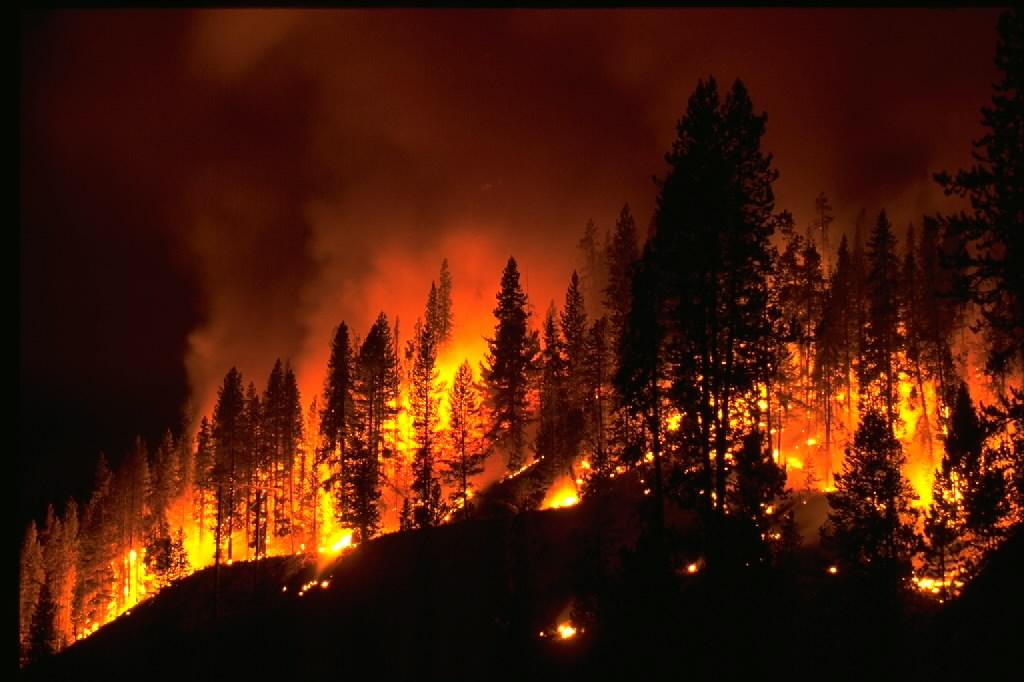30 April 2012
Smoking out an air pollutant’s hot spots
Posted by kramsayer

When biomass burns, including during wildfires, it releases a pollutant that can cause health problems at high concentrations. (Credit: NOAA)
Author Katy Human is a science writer at the National Oceanic and Atmospheric Administration in Boulder, Colo.
A smoke-related chemical may be a significant air pollutant in some parts of the world, especially in places where forest fires and other forms of biomass burning are common, according to new research.
In a modeling study, scientists found that relatively high levels of the chemical, called isocyanic acid, are likely occur in parts of tropical Africa, Southeast Asia, China, Siberia, and the Western Amazon Basin.
“This is the first study to model the global distribution of isocyanic acid, and the concentrations we estimated for many regions are high enough to warrant more research to understand people’s exposures,” said Paul Young, lead author of the paper published online Friday in the Journal of Geophysical Research-Atmospheres, a journal of the American Geophysical Union. Young is an atmospheric scientist with NOAA’s Earth System Research Laboratory and the Cooperative Institute for Research in Environmental Sciences at the University of Colorado at Boulder.
Isocyanic acid is emitted by burning biomass, such as forest fires. People who cook or heat their homes using inefficient stoves could get significant exposure to the chemical. In the body, isocyanic acid can trigger certain kinds of protein damage which, in turn, leads to cataracts and inflammation associated with cardiovascular disease and rheumatoid arthritis, according to published health research.
NOAA scientists published a study last year that was one of the first to observe the acid in the air. Using a NOAA-built custom instrument, the researchers found the chemical downwind of a Colorado wildfire, in cigarette smoke, and in the air of downtown Los Angeles. In LA, the source of the chemical remains unknown, but possibilities include emission control devices, regional wildfires, and light-driven chemical reactions. That study also suggested that if the acid was present in the air at 1 part per billion by volume (ppbv) or higher, it could trigger chemical reactions associated with negative health effects; it was below that concentration in the California and Colorado air.
In the new study, Young and his colleagues investigated further, using a sophisticated computer model of the atmosphere to better understand the chemical’s distribution around the globe. Their model used the limited information available on isocyanic acid to include processes that remove the chemical from the atmosphere and to estimate its emissions.
The researchers found that annual average levels of isocyanic acid are likely highest in parts of China, where modeled concentrations reached 0.47 ppbv (about half of the 1 ppbv suspected to trigger health concerns). But at certain times, the pollutant spiked significantly higher in regions where episodic fires occurred: Isocyanic levels periodically reached 4 ppbv in parts of tropical Africa and the Western Amazon Basin, and up to 10 ppbv in Southeast Asia and Siberia.
In parts of Siberia and tropical Africa, modeled isocyanic acid levels surpassed 1 ppbv for more than 60 days out of the year, the team reported. In more populated areas, however, exposure is potentially more significant: For Southeast Asia, the scientists estimated that more than 50 million people could be exposed to levels of isocyanic acid above 1 ppbv for more than seven days in one year.
Isocyanic acid is difficult to detect in the atmosphere with conventional measurement techniques, and the emissions estimates in the new paper are likely significantly underestimated in some parts of the world (where inefficient stoves are common), and possibly overestimated in others (where fossil fuel burning for electricity is more common).
“Our estimates are preliminary,” said co-author Jim Roberts, a NOAA chemist. “But given the potentially high concentrations of isocyanic acid in those hotspots, and the numbers of people potentially affected, we hope that more atmospheric scientists and health researchers will be encouraged to look into this issue.”
-Katy Human, NOAA science writer (For NOAA’s version of this feature, visit http://researchmatters.noaa.gov/news/Pages/IsocyanicAcidStudy.aspx)


 GeoSpace is a blog on Earth and space science, managed by AGU’s Public Information staff. The blog features posts by AGU writers and guest contributors on all sorts of relevant science topics, but with a focus on new research and geo and space sciences-related stories that are currently in the news.
GeoSpace is a blog on Earth and space science, managed by AGU’s Public Information staff. The blog features posts by AGU writers and guest contributors on all sorts of relevant science topics, but with a focus on new research and geo and space sciences-related stories that are currently in the news.